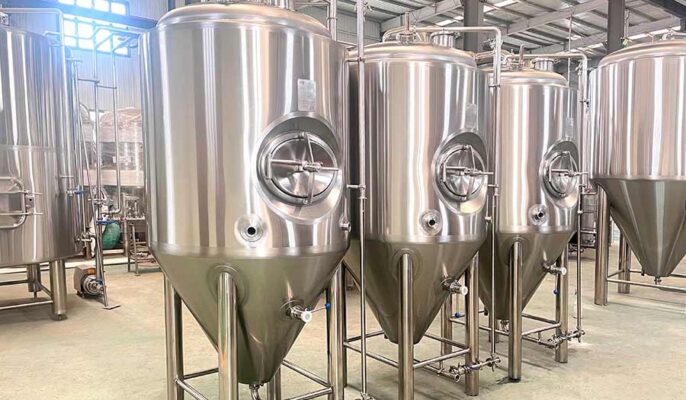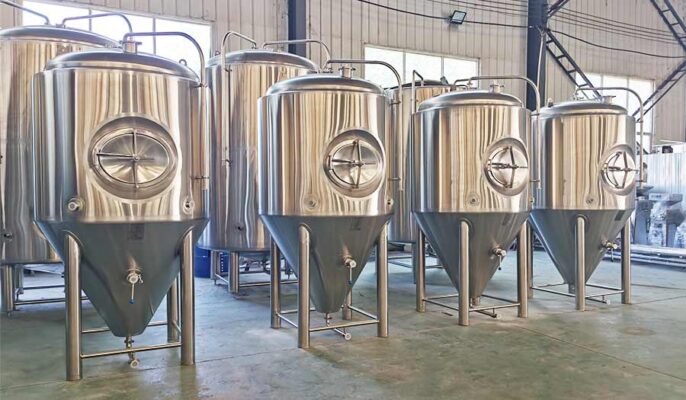Large breweries have relied on separate fermenters and sake tanks to produce their products. But with the rise of craft beer and home brewing, single-can beers have taken on a more prominent role in the industry. In this article, we want to show you the advantages of using a brewing unit tank compared to a fermentation tank so that you know whether a fermenter or a unit tank is the better option in the long run.
O que é um fermentador?
The fermentation vessel (FV), referred to as the fermentor, is where the wort is stored when yeast ferments it into beer. Fermentation tanks are available in a variety of sizes and shapes and are made from different products, one of the most well-known ones including plastic, glass, and stainless steel.
What is a unit tank?
Combined Tanks emerge as bold new contenders, challenging the status quo. These conical tanks are very like primary fermenters, but have a few secret weapons. With unit tanks, primary and secondary fermentations can be carried out in the same vessel. The beer can thus be fermented, matured, purified, dry-hopped and carbonated in one tank. This means brewers can say goodbye to their lees before moving on to the next stage. But be aware that unit tanks sacrifice some clarity and richness for convenience and cost-effectiveness.

Which one should I choose, fermenter or Unitank?
If you are a brewer, you know how important it is to choose the right equipment for your fermentation process.
Fermentação primária
The union of yeast and wort begins in the fermenter. It is during primary fermentation that the yeast absorbs the sugar, converting it into delicious alcohol. But wait, there’s a twist! Besides to this fascinating process, heavy fats, proteins, debris, and even dead yeast can settle at the bottom of the tank, forming the infamous lees.
Independente cuba de fermentação
The beer fermentation tank ensures that the beer is crystal clear and dazzling without any hazy interference. After the primary fermentation, the beer is transferred to Brite tanks where it undergoes secondary fermentation. Here, the residue (dregs) left in the first tank remains a thing of the past, resulting in crystal clear beer.
Unitank
A typical unit tank is a conical tank that looks like a primary fermenter. But, it has the added function of removing sediment before secondary fermentation. The single-tank model allows breweries to complete primary and secondary fermentation in the same tank, followed by carbonation.
The advantages of a combined tank are a smaller footprint and less financial investment. The downside is that it doesn’t produce a super clear and rich flavor. This may be fine for some beer recipes that don’t need higher levels of differentiation. But, when winemakers are pursuing specific flavor profiles and superior clarity, individual fermenters are a better choice.
Benefits of using brewing unit tanks and fermenters
UNITANK simplifies the brewing process
The biggest benefit of using unit tanks instead of fermenters is that it simplifies the brewing process. When you choose to brew with a monoblock tank, you can keep many steps of the brewing process in one device. You can ferment and age beer in a single tank without having to move the beer from one location to another. This means less actual labor in the entire process, since you don’t need to transfer the beer to a different piece of equipment for each new brewing step.
Lower costs for startups
Starting your own brewing business requires some large upfront costs. The right equipment will save you considerable money, so it’s best to find places to reduce costs wherever possible. Due to their versatile nature, Unitanks make the start-up costs of a new brewery more affordable. The less new equipment you need to buy, the more money you spend on the beer itself.
Reduce pollution
Any time you need to move your beer from one place to another, or any time you expose your beer to the elements outside of your current tank, you run the risk of contaminants getting in. Contamination caused by microorganisms or dissolved oxygen is a serious problem and a combined tank can help. Jacketed monoblock tanks allow you to keep your beer for longer, protecting it from potential external contaminants that can completely destroy its flavor.
Easy to distribute
Finally, beer can be served from the unit tank itself without having to transfer it elsewhere. Many traditional fermenters don’t have this feature, which makes it harder to have beer ready when customers come over, especially for smaller operations. If you plan on visiting a brewery, a joint tank can give your customers the freshest taste of the latest beer you’re brewing.

Choosing the right solution for your brewery: Fermenters vs. Unit Tanks
Precautions for conical cubas de fermentação
- Brewing style: If you focus on clarity, precision and refined flavor profiles, conical fermenters are an excellent choice. They excel at producing clean and appealing beers, making them ideal for beers that need special clarity, such as lagers and pilsners.
- Production volume: Conical fermentation tanks are available in various sizes, suitable for small and large-scale production. Consider your current and projected production volumes to ensure the fermenter you choose will meet your needs.
Factors to consider with Unitank
- Space constraints: If your brewery has limited floor space or you want to maximize efficiency in a compact area, unit tanks can provide a space-saving solution by consolidating many fermentation stages into a single vessel .
- Brewing flexibility: Unitanks enable you to experiment with different beer styles and flavor profiles without the need for separate containers. This flexibility is particularly attractive to craft breweries that focus on innovation and creative expression.
- Production efficiency: Simplifying the brewing process and reducing transfer steps saves time, labor and minimizes the risk of contamination. If efficiency and productivity are key factors for your brewery, then unit tanks offer compelling advantages.
In the conical fermenter vs. unit tank debate, there is no absolute answer. Your decision should be guided by your specific brewing goals and operating requirements. No brewery can afford to use low-quality equipment. Whether your operation uses individual fermenters or a single fermenter, you need equipment you can trust. Micet has brewing equipment suitable for breweries of all sizes. Whether you need unit tanks or fermenters, we can help you find the equipment you need to keep your brewery growing.




